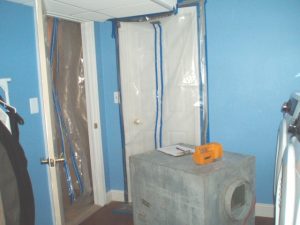Mold Remediation Guide: Do’s and Don’ts
Although basically simple, mold remediation needs to be done correctly to prevent further contamination of the building. Any area greater than 30 square feet should be completed by a certified microbial remediation company.
The steps involved in proper microbial remediation are:

- Empty the area or room of all removable items. Throw away porous materials that have mold on them. Wipe off hard surface items with a 10 % bleach solution. Wash clothes, bedding or other such items in hot water and detergent or have them dry-cleaned. Items that can’t be removed should be covered with plastic.
- Close off the area or room with plastic and seal off any conveyance into another area.
- Put the area or room under negative pressure by using an air machine. Have a means of supplying clean, fresh air into the space.
- Remove all mold-compromised drywall, carpeting, paneling, etc. Immediately place in sealed plastic bags and dispose of in the trash. Removal should be at least 6 inches beyond where mold growth is seen.
- Examine behind the walls where drywall is removed to see if there is mold growth the other side of the wall. Remove mold-compromised materials such as insulation.
- Sand mold off of plaster or wood that can’t be removed.
- HEPA vacuum and tack-wipe all surfaces in the area or room where the mold was found.
- An independent third party should conduct clearance sampling & analysis to ensure that the remediation contractor has removed and cleaned all contamination.
- Follow-up with a biocide application and/or mold-inhibiting encapsulants.
The Importance of Protocols during Mold Remediation
- All work should be done by workers using personal protective equipment such as P100 respirators, coveralls, gloves, and safety glasses.
- After the removal of the mold, the rest of the building should be thoroughly cleaned by wiping down all hard surfaces including walls, ceilings and floors. Porous surfaces such as carpet, curtains and furniture should be HEPA vacuumed. The duct work and HVAC system should be cleaned if there was a connection to the mold-contaminated area.
- Most important of all, all sources of water intrusion or high humidity must be corrected prior to the start of the remediation, or the moldy conditions will return.
Turn-Key provides oversight of mold remediation in Dayton Ohio as an independent third party. (link to mold services page)


